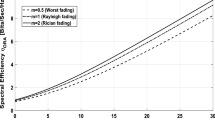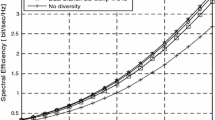Abstract
To overcome the performance limit of multi-branch switch and stay combining (SSC) systems, the branches are divided into a pair of sub-SSC systems that are connected to selection combining. To evaluate the proposed system, the general mathematical expressions of average output signal-to-noise ratio (SNR) for the independent Nakagami-m fading branches are provided. There are deduced for the case in which one branch has higher or lower average SNR than the other branches. We also perform a numerical analysis, and demonstrate that this simple structure reconfiguration considerably increases the performance of SSC systems in several environments.




Similar content being viewed by others
References
Stüber, G. L. (2017). Principles of mobile communication (4th ed.). Norwell, MA: Springer.
Williams, J. M., Khanna, R., Ruiz-Rpsero, J. P., Pisharody, G., Qian, Y., Carlson, C. R., et al. (2017). Weaving the wireless web: Toward a low-Power, dense wireless sensor network for the industrial IoT. IEEE Microwave Magazine, 18(7), 40–63.
Mosenia, A., Sur-Kolay, S., Raghunathan, A., & Jha, N. (2017). Wearable medical sensor-based system design: A survey. IEEE Transactions on Multi-scale Computing Systems, 3(2), 124–138.
Blanco, M., & Zdunek, K. (1979). Performance and optimization of switched diversity systems for the detection of signals with Rayleigh fading. IEEE Transactions on Communications, 27(12), 1887–1895.
Abu-Dayya, A. A., & Beaulieu, N. C. (1994). Switched diversity on microcellular Ricean channels. IEEE Transactions on Vehicular Technology, 43(4), 970–976.
Abu-Dayya, A. A., & Beaulieu, N. C. (1994). Analysis of switched diversity systems on generalized-fading channels. IEEE Transactions on Communications, 42(11), 2959–2966.
Yang, H.-C., & Alouini, M.-S. (2003). Performance analysis of multi-branch switched diversity systems. IEEE Transactions on Communications, 51(5), 782–794.
Prasad, R. (1998). Universal wireless personal communication. Norwood, MA: Artech House.
Ko, Y.-C., Alouini, M.-S., & Simon, M. K. (2000). Analysis and optimization of switched diversity systems. IEEE Transactions on Vehicular Technology, 49(5), 1813–1831.
Simon, M. K., & Alouini, M.-S. (2002). Digital communication over fading channels: A unified approach to performance analysis. Hoboken: Wiley.
Win, M. Z., & Winters, J. H. (1999). On maximal ratio combining in correlated Nakagami channels with unequal fading parameters and SNRs among branches: An analytical framework. Wireless Communications and Networking Conference, 3, 1058–1064.
Alouini, M.-S., & Simon, M. K. (2000). An MGF-based performance analysis of generalized selection combining over Rayleigh fading channels. IEEE Transactions on Communications, 48(3), 401–415.
Gradshteyn, I. S., & Ryzhik, I. M. (2007). Table of integrals, series, and products (7th ed.). Cambridge: Academic Press.
Abramowitz, M., & Stegun, I. A. (1965). Handbook of mathematical functions: With formulas, graphs, and mathematical tables. New York: Dover.
Chen, Y., & Tellambura, C. (2004). Distribution functions of selection combiner output in equally correlated Rayleigh, Rician, and Nakagami-m fading channels. IEEE Transactions on Communications, 52(11), 1948–1956.
Acknowledgements
The author would like to thank anonymous reviewers for their thoughtful and valuable comments, which increased the quality of this paper.
Author information
Authors and Affiliations
Corresponding author
Additional information
Publisher's Note
Springer Nature remains neutral with regard to jurisdictional claims in published maps and institutional affiliations.
Rights and permissions
About this article
Cite this article
Oh, S., Yoon, J. & Cho, T. Design of Simple and Efficient Multi-branch Selection Combining System. Wireless Pers Commun 104, 1065–1074 (2019). https://doi.org/10.1007/s11277-018-6067-9
Published:
Issue Date:
DOI: https://doi.org/10.1007/s11277-018-6067-9




